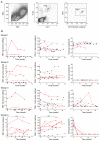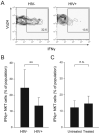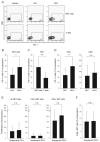Severe functional impairment and elevated PD-1 expression in CD1d-restricted NKT cells retained during chronic HIV-1 infection
- PMID: 19197939
- PMCID: PMC2736548
- DOI: 10.1002/eji.200838780
Severe functional impairment and elevated PD-1 expression in CD1d-restricted NKT cells retained during chronic HIV-1 infection
Abstract
Invariant CD1d-restricted NKT cells play important roles in regulating both innate and adaptive immunity. They are targeted by HIV-1 infection and severely reduced in number or even lost in many infected subjects. Here, we have investigated the characteristics of NKT cells retained by some patients despite chronic HIV-1 infection. NKT cells preserved under these circumstances displayed an impaired ability to proliferate and produce IFN-gamma in response to CD1d-restricted lipid antigen as compared with cells from uninfected control subjects. HIV-1 infection was associated with an elevated expression of the inhibitory programmed death-1 (PD-1) receptor (CD279) on the CD4(-) subset of NKT cells. However, blocking experiments indicated that the functional defects in NKT cells were largely PD-1-independent. Furthermore, the elevated PD-1 expression and the functional defects were not restored by anti-retroviral treatment, and the NKT cell numbers in blood did not recover significantly in response to treatment. The functional phenotype of NKT cells in these patients suggests an irreversible immune exhaustion due to chronic activation in vivo. The data demonstrate a severe functional impairment in the remaining NKT-cell compartment in HIV-1-infected patients, which limits the prospects to mobilize these cells in immunotherapy approaches in patients.
Figures




References
-
- Sandberg JK, Ljunggren HG. Development and function of CD1d-restricted NKT cells: influence of sphingolipids, SAP and sex. Trends Immunol. 2005;26:347–349. - PubMed
-
- Fujii S, Shimizu K, Hemmi H, Steinman RM. Innate Valpha14+ natural killer T cells mature dendritic cells, leading to strong adaptive immunity. Immunol. Rev. 2007;220:183–198. - PubMed
-
- Dougan SK, Kaser A, Blumberg RS. CD1 expression on antigen-presenting cells. Curr. Top. Microbiol. Immunol. 2007;314:113–141. - PubMed
-
- Stronge VS, Salio M, Jones EY, Cerundolo V. A closer look at CD1d molecules: new horizons in studying NKT cells. Trends Immunol. 2007;28:455–462. - PubMed
Publication types
MeSH terms
Substances
Grants and funding
LinkOut - more resources
Full Text Sources
Medical
Research Materials

